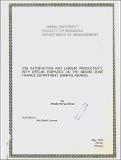| dc.description.abstract | The human factors are always referred as to be the most critical elements in the productivity process. Whether it is a manufacturing organization or a one which renders service, human intelligence and efforts are still non-substitutable assets, as some refer to them. .It appears that human involvement is initial in every business operation be it hunting and gathering in ancient society, or specialization in commerce, war and administration in the medieval ages or labor specialization in the early industrial revolution. Though the scope of human involvement in different work practices is slightly declining for technological advancement and risk considerations, a great deal of work is still being performed by human-beings' direct or indirect participation.
Despite this fact in the long man history, the fact that human intelligence and efforts are critical to the success of any operations undertaken by organizations, questions still remain unanswered. Are human or personnel policies and practices given due consideration? The great industrial revolution gives us accounts of remarkable changes made to improve the production process so as to boost the efficiency and effectiveness of the organizational activities. We have now arrived to the ages of information technology, computer aided design, computer aided manufacturing, Robotics technology etc. through time taking changes just from the Stone Age. But are human factors getting enough attention as we did with other means of production? If so, how are these human resource practices related to performance level by employees?
The effort of this paper will be studying the possible linkage between
Human Resource Management practices and the productivity level of employees. The paper strives to reveal the way in which human resource practices are related to employee performance in addition to finding the link. Relations are to be sorted, if any, between employee productivity and different motivational factors like company and administrative policies, supervision, salary (compensation), interpersonal relations, working conditions, the work itself, opportunity for advancement and recognition, chances for achievement and co-workers. | en |


